ISKCON 50 Meditations: August 8, 2016
By Satsvarupa dasa Goswami | Aug 08, 2016

The Peace Vigil at the U.N.
Some met at the storefront and went by bus, carrying karatalas, a tambourine, and the Swami’s bongo. Swamiji rode with a few of his followers in a taxi. The typical dress of his followers consisted of well-worn sneakers, black pants or blue jeans, and T-shirts or button-down sport shirts. Travelling uptown in the early morning put the boys in a lighthearted spirit, and when they saw Swamiji at the U.N. in his flowing saffron robes they became inspired. Swamiji began the chanting, but right away the peace vigil organizers stepped in and asked him to stop. This was a “silent vigil” they said, and it should have prayerful, non-violent silence. The boys were crushed, but Swamiji accepted the restriction and began silently chanting on his beads.
A dignitary stood up before the assembly and made a short speech in which he mentioned Gandhi, and then he turned to Prabhupada and indicated that he could now speak about peace. Standing erectly, the U.N. skyscraper looming behind him, Swamiji spoke in a soft voice. The world must accept that God is the proprietor of everything and the friend of everyone, he said. Only then can we have real peace. Mr. Bogart had scheduled the Swami for two hours of silent prayer. Prabhupada had the devotees sit together and softly chant japa until their two scheduled hours were up. Then they left.
As Prabhupada rode back downtown in the heavy morning traffic, he said New York reminded him of Calcutta. Amid the start-and-stop motion and noise of the traffic he explained, “We have nothing to do with peace vigils. We simply want to spread this chanting of Hare Krishna, that’s all. If people take to this chanting, peace will automatically come. Then they won’t have to artificially try for peace.”















